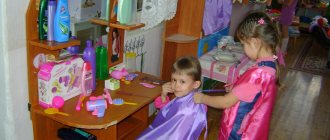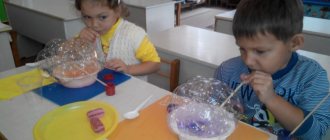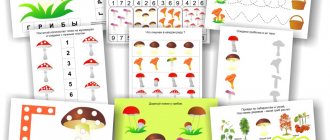Summary of mathematical leisure in the senior group “Journey to the Land of Mathematics”
Summary of mathematical leisure in the senior group
"Journey to the Land of Mathematics"
Target:
Testing mathematical knowledge in a playful, entertaining way: in counting, the ability to independently complete tasks in a competitive environment.
Objectives:
Educational:
Learn to solve problems involving increasing and decreasing a number by several units. Maintain counting within 8, knowledge of numbers up to 8.
Developmental:
To form in children ideas about the relationships of numbers in a number series, to identify and name the previous and subsequent ones in relation to the named number (numbers and “neighbors”).
Develop attention, memory, thinking. Educators:
Develop the ability to work in a team, provide assistance, support, endurance and patience.
Material, tools, equipment:
Demonstration material: a set of numbers from 1 to 8, cubes, 3 hoops, multi-colored colored apples. Handouts: geometric shapes, cards with numbers.
Vocabulary work:
Digital city, numbers “neighbors”, travel, right, left, below, up, near, previous, next.
Preliminary work:
introducing children to the number and number 8, time of day, problem solving.
Methods and techniques:
game motivation, questions for children, explanation, instructions for implementation, practical actions of children, musical accompaniment, didactic games.
OOD progress:
Organizing time
Communicative exercise “Hello.” Educator. Today we are going to the amazing country of Mathematics. In the capital of the country of Mathematics - Digital City - we will play, count and solve fun problems. And to get to the country of Mathematics, you need to close your eyes and say the magic words:
“1, 2, 3, 4, 5 Let's start playing! We close our eyes, We find ourselves in the country of Mathematics! (the teacher puts on a cape, a crown, turns into a fairy Mathematics) Fairy. I am glad to welcome you to my city Tsifrograd! But you can't just come here. You need to solve fun problems and show the answers in numbers.
2. Warm up.
Solving problems involving increasing and decreasing a number by several units. 1) How many boots did Olya buy so that the cat wouldn’t get her paws wet? (4) 2) Seryozhka fell into the snow, and behind him - Alyoshka, And behind him - Irinka, and behind her - Marinka, And then Ignat fell, How many guys are there in the snow? (5) 3) On Andryusha’s saucer are four yellow pears. The child wanted to eat, and he ate one of the pears. Now count the pears on Andryusha's saucer. (3) 4) A hedgehog walked through the forest, Found mushrooms for lunch: Two under a birch tree, One at an aspen tree, How many of them will there be in a wicker basket? (3) 5) Five puppies Plus mother - husky. How much will? Count it up! (6) 6) Six cheerful bear cubs are rushing into the forest for raspberries, But one baby is tired, Has fallen behind his comrades, And now find the answer: How many bears are ahead? (5) (cards with numbers are arranged on a magnetic board in a different order) Fairy: Guys, you solved the problems correctly! Therefore, I invite you to the land of Mathematics. Do you know that bears in my country love mathematics, they know how to solve problems, add and subtract, and also have fun and play. I invite you to play too.
Physical education minute.
Song of a teddy bear (ry - ra - ru).
3. Didactic game “Fold the house.”
Fairy: One bear cub, in my country, does not have his own house. He knows a lot of geometric shapes and wants to build a house out of them, but doesn’t know how. Shall we help him? Geometric shapes are waiting for you on the table. Fairy: You have created wonderful houses! What geometric shapes did you use? There are so many houses, but only one bear. He will choose a house for himself, but what to do with the rest of the houses? Can I give these houses to the residents of my fairy-tale country?
4. "Game with apples."
Fairy: The bear already has a house, but let's treat the bear with apples. Apples are not simple, with different numbers of seeds inside. You will run to the music, and as soon as it stops, take one apple at a time. Count the seeds in the apples and stand near the number in the hoop. How hard you tried! All the apples have been collected. Tired. It's time to relax!
5. Physical school
(with musical accompaniment)
6. Didactic game “Live numbers”.
Fairy: Have you rested? And in my country, Mathematicians, there are living numbers. Do you want to play with them? Cards with numbers are laid out on the table. Children take them and insert them in order from 1-8. The teacher suggests making a count: quantitative, reverse. Tasks: - Show the “neighbors” of the number 5 and name them. - Show the “neighbors” of the number 7 and name them. - Show the number 1 more than 2. - Show the number 1 less than 4. - Show the number before the number 8. - Show the number after the number 5. - Show the number to the right of the number 4. - Show the number to the left of the number 7.
7. Didactic game “Find the number.”
(children stand in 2 teams) Rules of the game: Come to me! There are cubes in front of you. Yellow cubes and green cubes. I'd like you to count them. And to do this you need to split into two teams. Team 1 goes around the yellow cubes and counts them. Team 2 goes around the green cubes and counts them. Each participant takes a card with a number corresponding to the number of cubes passed. Team 1, show cards with numbers. How many cubes? How to check who counted correctly? 2nd team, show cards with numbers. How many cubes? How to check who counted correctly?
8. Reflection.
Fairy: Guys, you completed all the tasks! Well done! We will continue to meet with you, but now it’s time for me to leave, and it’s time for you to return. Close your eyes.
1, 2, 3, 4, 5 We're done playing. We close our eyes and leave the fairy tale!
Educator: Our journey has ended. Where have you been? What did you like about the country of Mathematics?
Math games for children's self-education
Developing children's mathematical abilities through play activities is the best and most common option. Before the start of the year, the teacher prepares a note, on the basis of which a card index is also compiled.
Examples of FEMP, with the help of which self-education of children in a group is carried out:
- Regular cans of different shapes and colors are used. Children begin to prepare food for the winter. The orientation is as follows - you need to collect vegetables and fruits that the autumn harvest provided. Mushrooms, cucumbers and tomatoes are suitable. The jars must be filled in accordance with the recipe provided by another participant in the game. So, if it says to put 1 cucumber and 4 mushrooms, then the jar should have exactly this composition.
- The teacher places a picture in front of the child and under it two cards with numbers. The child’s task is to count how many objects are in the picture and put a sign - greater than, less than or equal to. For example, in the image from the book there are 5 flowers and 2 clouds, which means there are fewer clouds.
- Game "Seasons". The teacher asks the children leading questions in order: what time of year is it now, what month will be next, what month has already passed, what will happen in 2 months.
How to learn letters correctly with a child 3-5 years old
Additional Information! Games in groups or individually are always accompanied by visual aids, cards, drawings, and musical compositions. It is easier for a child to learn new information in an interesting way.
Mathematical game orientation in space
An open lesson in mathematics for children in the middle group in a playful form may include didactic games on moving in space and orientation.
Card index of games for preschool educational institutions:
- Unusual hide and seek. Unlike the standard option, in this case the teacher hides the toy in the kindergarten and tells the children that they need to find it. At the same time, he gives hints, saying “to the left” or “to the right”, “at the far wall”, “high”, “low”. Listening to the clues, children must quickly find the hidden toy. If it’s autumn or spring outside, you can complicate the task and arrange a similar game outside the walls of the kindergarten.
- Checkboxes. The teacher hides flags around the room, but to find them, children must follow the directions. So, he needs to take “three steps to the right, two steps forward and turn to the window.”
- Dictation. Leaves are issued in a box. Using a pencil, children draw under the dictation of the teacher. He says: “Two cells up, one to the left, three cells down, one to the left.” The result should be a drawing.
Graphic dictation
- Guess what's wrong. One child leaves the room while the others rearrange objects. After this, the one who returned must try to guess what has changed. For example: “The Masha doll is now lying on the floor, but stood on the chest of drawers, or the flower was on the windowsill, and not on the table.”
- Quest. The teacher tells the children that Carlson visited the kindergarten at night and brought something. This is a new toy. But to find it, you need to follow the directions. First, the children follow the teacher's lead and find a note that contains tips for the game.
Card index of games on life safety for senior and preparatory groups according to the Federal State Educational Standard
Important! Before a child enters first grade, he must learn to understand where “right” and “left” are, which numbers are larger and which are smaller. The essence of didactic games is that development occurs in a playful way, unobtrusively. The kid gets involved in the process and doesn’t want to stop in the future, because he wants to find as many items as possible and win.






